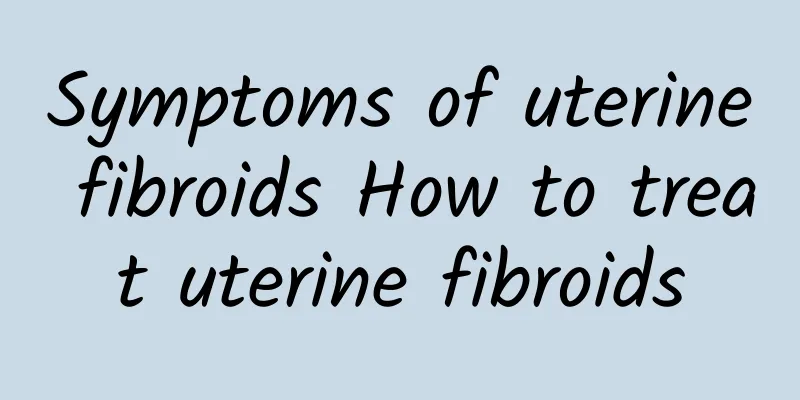Symptoms of uterine fibroids How to treat uterine fibroids

|
The uterus is an important organ in the female body. Once a lesion occurs, we will be unable to have children, and even threaten our lives. I hope that female friends can pay more attention to their health and prevent the occurrence of uterine fibroids. Let us understand the symptoms and manifestations of uterine fibroids? So that we can detect and treat them early. 1. Subserosal fibroids: Subserosal fibroids are a common type of uterine fibroids. Subserosal fibroids are a common type, accounting for about 20%. Intramural fibroids develop into serosa, protrude from the surface of the uterus, and directly contact the serosa layer. If they grow between the leaves of the broad ligament, they are intra-broad ligament fibroids. 2. Cervical fibroids: As the name implies, cervical fibroids mainly appear in the cervix and sometimes compress the pelvic cavity. Cervical fibroids grow in a low position and can be embedded in the pelvic cavity, causing compression symptoms. Surgical removal is difficult and can easily damage the ureter and bladder. It is also a rare type of uterine fibroids. 3. Intramural fibroids: Intramural fibroids are also a typical type of uterine fibroids, which are more likely to occur than other types. Uterine fibroids are more common when they first occur, located within the uterine muscle wall and surrounded by the myometrium. They are the most common uterine fibroids in women, accounting for about 60-70% of the incidence of all uterine fibroids. 4. Submucosal fibroids: This type of uterine fibroids mainly appears in the uterine cavity and will have a certain impact on female pregnancy. Submucosal fibroids account for about 10%, which are formed by intramural fibroids growing in the uterine cavity, protruding in the uterine cavity, and directly contacting the mucosal layer. This tumor can gradually increase the deformation of the uterine cavity and is often connected to the uterus. For example, the pedicle is long and can block the cervix or detach from the vagina. Clinical symptoms of uterine fibroids: Increased vaginal discharge: Intramural fibroids increase the area of the uterine cavity, increase endometrial gland secretion, and are accompanied by pelvic congestion, leading to increased vaginal discharge. If it is a submucosal fibroid, its surface is prone to infection and necrosis, producing a large amount of pus and blood secretions, accompanied by odor. Abnormal urination and defecation: If the uterine cervix, broad ligament and other myomas are large or growing, the clinical manifestations of uterine myomas may show clinical symptoms of squeezing the adjacent pelvic organs, such as constipation, frequent urination, increased residual urine, ureteral displacement, and hydronephrosis. Menstrual changes: When the uterine cavity becomes larger, the area of the endometrium increases, the uterus contracts poorly or the endometrium proliferates excessively, or there are submucosal fibroids. The clinical manifestations of uterine fibroids can prolong menstruation and cause menorrhagia. If not treated in time, it will lead to anemia. Abdominal mass: When the mass is large or grows too rapidly, the clinical manifestation of uterine fibroids is usually a lump that can be felt in the middle of the lower abdomen, which is hard in texture, especially in the morning when the bladder is full. |
<<: What are the symptoms of uterine fibroids? What should be checked for uterine fibroids?
>>: Symptoms of uterine fibroids Are the symptoms of uterine fibroids obvious?
Recommend
How to prevent dysmenorrhea?
At present, clinically, it is often divided into ...
What are the precautions for the treatment of acute pelvic inflammatory disease?
What precautions should be taken in the treatment...
What to do if you have irregular menstruation due to anemia?
What to do if you have irregular menstruation due...
How to take care of irregular menstruation with diet? You can eat these 4 foods for irregular menstruation
Irregular menstruation is a headache for many wom...
Can female cervicitis lead to infertility? What are the causes of female cervicitis leading to infertility?
In real life, there are many women suffering from...
Understanding the diagnostic criteria for acute cervicitis
What are the main diagnoses of acute cervicitis? ...
Does motherwort have the effect of inducing menstruation? Yes, it can.
Motherwort can promote menstruation. Motherwort i...
Women should know under what circumstances dysmenorrhea occurs
Women should have some understanding of dysmenorr...
How much do you know about the dangers of uterine fibroids?
Uterine fibroids, as the name suggests, are a typ...
Understand the harm of pelvic inflammatory disease to women
Pelvic inflammatory disease is a common gynecolog...
Lily medicinal cuisine is popular
Lily is a perennial bulbous flower, and its culti...
Vaginitis is likely to cause increased leucorrhea
Vaginitis is likely to cause an increase in vagin...
Should you worry about cervical erosion becoming cancerous? Teach you how to prevent cervical cancer
Cancer is scary! Cervical cancer has killed count...
Diet care for pelvic inflammatory disease
Pelvic inflammatory disease is one of the common ...
What medicine should I take to control and treat uterine mucosal fibroids? Treatment methods for uterine mucosal fibroids
Uterine mucosal fibroids are a common gynecologic...









